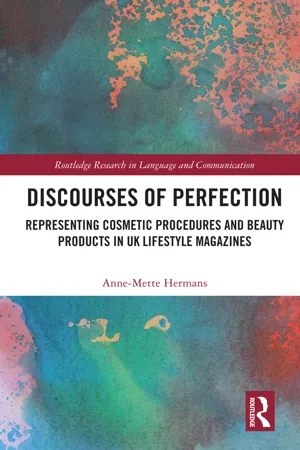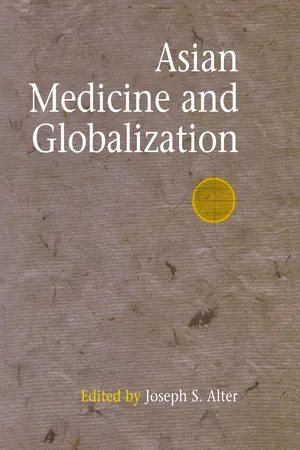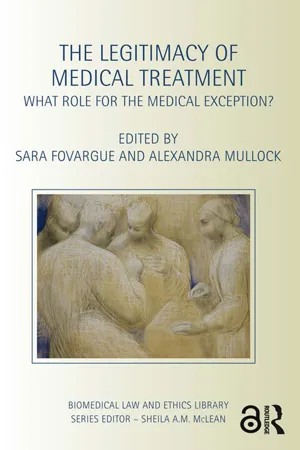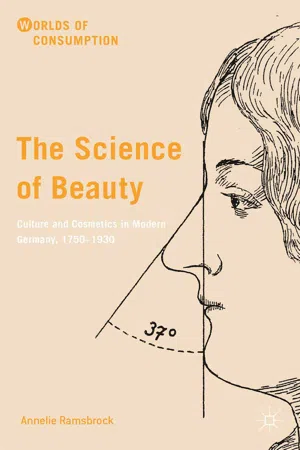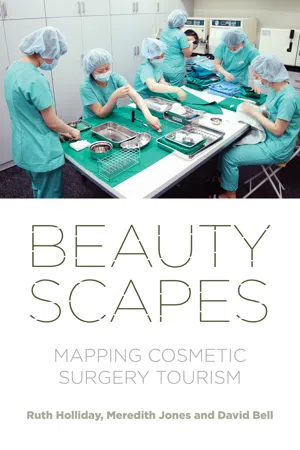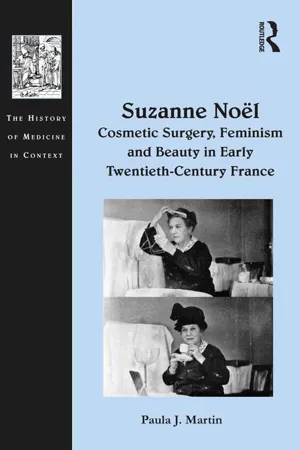History
Cosmetic Surgery
Cosmetic surgery refers to medical procedures aimed at enhancing a person's appearance through surgical and medical techniques. Its history can be traced back to ancient civilizations, where rudimentary forms of cosmetic surgery were performed. Over time, advancements in technology and medical knowledge have led to the development of a wide range of cosmetic surgical procedures to address various aesthetic concerns.
Written by Perlego with AI-assistance
Related key terms
8 Key excerpts on "Cosmetic Surgery"
- eBook - ePub
- Bryan S Turner(Author)
- 2012(Publication Date)
- Routledge(Publisher)
Technologies and Body Modification
Passage contains an image
24 Getting Work Done
Cosmetic Surgery as Constraint, as Commodity, as Commonplace Heather Laine Talley DOI: 10.4324/9780203842096-25Aesthetic surgery is simultaneously an ancient and a distinctly modern practice. The desire to change what our bodies look like is not new, and the techniques of modern Cosmetic Surgery are startlingly similar to surgical procedures completed in ancient India and Greece. Yet, Cosmetic Surgery as it is currently practiced by doctors, consumed by patients, and pictured in the cultural imagination is entirely contemporary. Cosmetic Surgery has become a prominent facet of popular and consumer culture. In certain ways, Cosmetic Surgery is another commodity like travel or cable television or wine that is consumed under the guise of increasing one’s quality of life. As a product bought and sold in the medical marketplace, Cosmetic Surgery is increasingly dissociated from its technological kin, reconstructive surgery, but Cosmetic Surgery shares a deeply intertwined history with surgery explicitly focused on repairing, as opposed to improving, appearance.The first recorded account of aesthetic reconstruction written in approximately 600 BCE India describes the process through which flaps of skin were cut from the cheek and forehead and attached to the nose or ear in order to reconstruct noses and earlobes of those who had been ‘disfigured’ through accident or reprimand (Chambers and Ray, 2009 ). Greek physicians attempted procedures at the beginning of the millennium, but gradually such medicine was denounced by the Catholic Church on the grounds that aesthetic intervention interfered with Divine Will. Yet, the desire to surgically alter bodily appearance did not disappear entirely. In the sixteenth century, an Italian surgeon Gaspare Tagliacozzi published the first book exclusively focused on plastic surgery, and a 1794 edition of The Gentleman’s Magazine described the ‘curious’ work of nose reconstruction, a procedure particularly useful in the age of syphilis, to the Western world. While initial efforts were almost entirely focused on repair, the late nineteenth century witnessed the emergence of surgery which employed reconstructive techniques for cosmetic purposes. At the turn of the twentieth century, people experimented with wax injections in order to contour the body, though given the tendency of free floating wax to migrate the risks most notably cancer clearly outweighed the benefits (Gilman 1999 ). To be sure though, World War I marks a turning point in the history of aesthetic surgery. Men returning from the war were disfigured in large numbers, and surgeons began to develop procedures that they hoped would help men integrate into their post war lives (Haiken 1999 - eBook - ePub
Discourses of Perfection
Representing Cosmetic Procedures and Beauty Products in UK Lifestyle Magazines
- Anne-Mette Hermans(Author)
- 2021(Publication Date)
- Routledge(Publisher)
The first comprehensive documentation of a reconstructive procedure dates back to circa 600 BC and details a procedure in which a new nose is constructed from flaps of skin (Haiken 1997; Jones 2008; Mendelson 2013). However, despite early experiments, plastic surgery, and especially Cosmetic Surgery, remained a niche specialty until fairly recently. Even when anaesthesia was developed and procedures could be performed with less risk of infection in the 19th century, only a few surgeons would undertake Cosmetic Surgery, as the Hippocratic Oath – which dictates not to intervene unless the potential benefits outweigh the risk of harm to a patient – “stopped most physicians from engaging in surgery for purely cosmetic purposes…” (Gilman 1999: 9; cf. Sullivan 2010: 407).During the First World War, reconstructive surgery as a medical specialty came to the fore as soldiers returned from the battlefield with severely scarred faces and bodies (Gilman 1999: 157). Moreover, industrialisation, urbanisation, technological advancements, the growth of consumer culture, and personal wealth in the Western world all contributed to the popularity of Cosmetic Surgery. Haiken (1997:7, 129) has pointed towards the significance of the inter-war years (1918–1939) for Cosmetic Surgery; the growing interest in psychology at the time and especially the concept of the inferiority complex, which “offered a compelling explanation and justification for the practice of Cosmetic Surgery”, caused an increase in the demand for cosmetic procedures as “Cosmetic Surgery, once associated with lack of mental balance and over-weening vanity, came to be seen as a step toward mental health”. In contemporary culture, Cosmetic Surgery is still often framed as a form of psychological help that promotes ‘inner well-being’ (cf. Gilman 1999; Mendelson 2013; Moran & Lee 2013; Pitts-Taylor 2007). This focus on healing a person’s (sense of) ‘self’ is evident in current marketing campaigns for cosmetic procedures, which, as will be shown in subsequent analyses, emphasise a procedure’s effect on people’s self-confidence.2.2.1 Cosmetic Surgery – Current State of the Market
Reflecting a worldwide trend, the UK Cosmetic Surgery industry has grown substantially since 2003 (see Table 2.1 )2 - eBook - ePub
- Joseph S. Alter(Author)
- 2013(Publication Date)
- University of Pennsylvania Press(Publisher)
shuangyanpi shoushu ), a relatively simple procedure in which a fold is added to the eyelid, transforming it from a stereotypical “single eyelid” Asian eye into a “double eyelid” eye, which is considered stereotypically European. I will return to this below.This brief summary of the establishment of Cosmetic Surgery in China and the career of its founder, Song Ruyao, illustrates the importance of the transnational flow of medical techniques through study abroad, conferences, visiting experts, medical journals and textbooks, and personal friendships. These techniques developed and moved around the globe in response to movements of people and culture that preceded them: to use Arjun Appadurai’s labels, Cosmetic Surgery moved along the terrain of the ethnoscape and technoscape (and was also conditioned by the finanscape and mediascape) of global culture (Appadurai 1990: 295–310).In short, Cosmetic Surgery did not arrive in China completely “emptied” of its Western meanings. On the contrary, those particular meanings took on new significance in the global and domestic political context of the 1960s and 1970s. Cosmetic Surgery was associated with the bourgeois pursuit of beauty then, and it still is. The difference is that within China the pursuit of beauty was formerly attacked and denounced, but after the end of Maoism it was glorified as a natural expression of human nature, of the personal freedom and individuality that had been suppressed under Mao. As of now, it does not yet appear that in China Cosmetic Surgery has become the symbol of artificial, decadent, and superficial beauty that one might think it is in the U.S., if one were to take the Hollywood comedians seriously. (However, its popularity in the U.S. puts the lie to that stereotype.)This history illustrates the notion of the “empty frame.” Cosmetic Surgery was a kind of bodily practice constituted within definite social and political contexts, and these contexts shaped the meanings that were attached to the practices. When these practices were associated with nations perceived as enemies, they were denounced and viewed with exaggerated notions of threat, rather than being neutralized, naturalized, and accepted. Ultimately, the changing domestic and international political context led to their neutralization, naturalization, and acceptance in China from the 1980s onward. It is important to remember that this process occurred at the cost of great personal suffering by practitioners like Song Ruyao. - eBook - ePub
The Legitimacy of Medical Treatment
What Role for the Medical Exception?
- Sara Fovargue, Alexandra Mullock, Sara Fovargue, Alexandra Mullock(Authors)
- 2015(Publication Date)
- Routledge(Publisher)
is proper medical treatment.The evolution of non-therapeutic Cosmetic Surgery: from pioneering medicine to (harmful) big business
Undergoing surgery as a beauty-enhancing treatment has become a lifestyle choice for increasing numbers of people. Over the past few decades, societal attitudes to Cosmetic Surgery have evolved, and there has been an increase in people electing to undergo such procedures. According to the British Association of Aesthetic Plastic Surgeons, 50,122 cosmetic procedures were performed in 2013, a rise of 17 per cent from 2012. The Cosmetic Surgery industry was worth £750m in the UK in 2005, £2.3bn in 2010, and is forecast to reach £3.6bn by 2015.18 As Sir Bruce Keogh’s review of the industry recently reported, rising demand for cosmetic enhancement has been driven by a number of socio-economic and technological factors, leading to the normalisation of serious and potentially harmful cosmetic interventions.19 Concern over the ethics of providing surgical enhancements on demand, and in exchange for payment, has led to cosmetic medicine undergoing what has been described as ‘an unfortunate transformation’ amounting to an ‘identity crisis’.20 In this context, the central aim of medicine, to heal and to serve the medical interests of the patient, seems to have been abandoned in favour of fulfilling desires fuelled by an ideology of youth and beauty.Central to the increasingly consumerist approach to Cosmetic Surgery is the commercial nature of the industry. Non-therapeutic Cosmetic Surgery is largely provided by the private sector in response to an individual’s request for cosmetic enhancement, rather than in response to disease or injury.21 It is rarely available through the NHS because there must be overriding physical or psychological reasons for considering it as a treatment option.22 A Clinical Commissioning Group may decide that Cosmetic Surgery is required for health reasons in rare cases, and examples may include breast implants to treat severe underdevelopment or asymmetry, breast reduction to treat back pain or shoulder pain, nose reshaping to treat breathing problems, or ‘tummy tucks’ to remove excess fat or skin after essential abdominal surgery.23 In order to obtain Cosmetic Surgery on the NHS, a plastic surgeon and a psychiatrist or psychologist must determine whether there is enough social, psychological, or physical benefit to the patient.24 However, the boundaries of these benefits are unclear, and there is no definition of what counts as enough physical or psychological benefit in this context, or severe underdevelopment of breasts, for example. In a society where larger breasts may be more aesthetically desirable, do smaller breasts cause some women social or psychological harm, and, if so, does this harm warrant therapeutic intervention? The lack of clarity here means that the availability of Cosmetic Surgery on the NHS may, in some cases, be controversial, such as where it is perceived as being provided for purely cosmetic reasons.25 These cases may be rare because in most cases the NHS will only fund Cosmetic Surgery where there is a clear clinical - eBook - ePub
- Bethanne Snodgrass, M. D.(Authors)
- 2009(Publication Date)
- HarperCollins e-books(Publisher)
Nevertheless, for centuries the quest for beauty, or at least the quest to become less unbeautiful, has motivated individuals to alter their appearance. The cultural implications of this quest have been debated by many, from feminists to economists, resulting in a number of interesting but so far unanswered questions about cosmetic medical care. For example, is Cosmetic Surgery a good thing or a bad thing? Are women cultural lemmings, hapless victims of marketing Svengalis, or are they exercising their rights to make decisions about their own bodies? What role do the media play in soliciting patients for cosmetic procedures? Are the media whores for advertisers, or is there really such a thing as independent content? How can a potential patient distinguish between hype and reality? What is the proper role of doctors on the pathway to cosmetic interventions? What risks should a person reasonably take to alter her or his appearance? Can beauty be defined?A prospective cosmetic medical patient must be able to articulate a personal definition of beauty because patients and providers need to agree on aesthetic goals before determining if those goals can be achieved. Western ideals of beauty have traditionally been based on rules of proportion and balance developed by the Greek philosopher Plato and his followers, and from these rules artists and plastic surgeons developed aesthetic norms that are often used to determine ideal facial ratios for patients undergoing reconstructive or cosmetic operations. Yet when anthropologists measure faces generally considered to be beautiful, these beauties often do not “measure up.” Their proportions fall outside the established ideals. Nonetheless, surgeons continue to use aesthetic norms when designing operations, and some still claim the classic Western proportions as the ideal. Only fairly recently have some cosmetic surgeons understood that all those brow-lift patients with the surprised appearance look that way because their eyebrows are simply up too far, partly as a result of surgeons using “ideal” measurements defined in the academic literature. By the same token, it certainly does not make sense for a patient to request Cosmetic Surgery to look like, say, Brad Pitt, because it is impossible to re-create all of the physical nuances that in toto are recognized as Brad Pitt’s face. - eBook - ePub
The Science of Beauty
Culture and Cosmetics in Modern Germany, 1750–1930
- Annelie Ramsbrock(Author)
- 2015(Publication Date)
- Palgrave Macmillan(Publisher)
Even cosmetic operations required a medically tenable justification. That’s why, in 1914, one aesthetic surgeon claimed that the profession first had to make its “importance” plausible before it could be “accepted as part of the overall science of medicine and medical practice.” 140 In this context, ideas about health and normality emerged that previously never held a place in medicine. What determined a normal appearance? A pathological one? When was a person healthy? When sick? Aesthetic surgeons negotiated these questions by undertaking “measurements on people” and developing psychophysical modes of thought. 141 The Psychophysical Indication Although aesthetic surgeries had been performed since the 1890s, their legitimacy was a matter of debate until the Great War. The issue was the Hippocratic oath, that is, the promise given by licensed physicians to only serve the aims of human health and life through their actions. Cosmetic operations were seemingly incompatible with this oath, some contemporary physicians maintained, since they merely served to create beauty, not cure a disease. Moreover, such procedures represented a threat to the health and life of the patients because they could not be performed without a scalpel and anesthesia. Thus, the view was widespread that it was not the “business of a doctor” to devote himself to the “appearance” of a person 142 At the same time, critical voices could not deny that the number of people wanting “surgical alterations to the shape of the nose [and] lips” had become “incredibly large.” 143 And there was no lack of surgeons willing to perform aesthetic operations and who had the technical skills to reduce the size of noses, flatten ears, lift wrinkles, or remove adipose tissue from the breasts and belly - eBook - ePub
Beautyscapes
Mapping cosmetic surgery tourism
- Ruth Holliday, Meredith Jones, David Bell(Authors)
- 2019(Publication Date)
- Manchester University Press(Publisher)
2007 ).However, it is important to note that when feminists began to write about Cosmetic Surgery – some thirty years ago – ‘the conglomeration of global, media, technological, and aesthetic conditions [that now make up Cosmetic Surgery tourism] was the stuff of science fiction’ (Heyes & Jones 2009 : 1), and that while the dominant feminist discourse has presented Cosmetic Surgery as damaging and disempowering, some feminist scholars have ‘always evinced a certain flexibility and curiosity about what Cosmetic Surgery might mean to individuals’ and their social contexts (7). How we think about Cosmetic Surgery now requires acknowledgement that local fashions and logistics intersect in complex ways with an ever-changing global landscape. Later in this chapter we outline the more nuanced (but less popular) feminist theoretical approaches to Cosmetic Surgery that we are building upon, and we also discuss this in more detail in chapter two . First, however, we provide a brief overview of Cosmetic Surgery tourism as a phenomenon, before moving on to discuss the way we approached researching it.Cosmetic Surgery tourism: the basicsCosmetic Surgery tourism can be defined as travel to access procedures that enhance appearance. It is a distinct segment of IMT with a distinctive patient profile, a particular set of geographies and a set of drivers (or motives) that share some commonalities with other forms of IMT but which in other ways diverge from them. It is a phenomenon made up of diverse actors, including those we focus on in Beautyscapes: patients, surgeons, facilitators and intermediaries, hospitals, governments, health systems, airlines, hotels, websites, social media and many more. As we show in chapter three - Paula J. Martin(Author)
- 2016(Publication Date)
- Routledge(Publisher)
In a democratic society where unfairness was often detested, and publically ridiculed, it is interesting that the distinction of beauty, naturally possessed by a fortunate few, was in France almost automatically accepted. The same can be said today as well. From a post-modern perspective and approximately one hundred years of modern plastic-surgical advancements later, it has finally brought to the forefront the realization that almost anyone can physically obtain what has culturally been established as beautiful, given enough money and tenacity. Although a primary reason beauty was often expected in Suzanne’s society was due to the advent of a beauty culture, for men and women living in the twenty-first century, Cosmetic Surgery has been democratized or, at least, given the illusion of democratization. Now as then, when all the facial creams advertised in the magazines fail to do as they promised, plastic surgery is still an option that actually delivers on the promise of beauty. This is not to say that everyone can afford plastic surgery, but it does mean that it is now available in a sufficient quantity to provide services to whoever can find the funds to pay for it. And, as the number of men and women who elect cosmetic surgical procedures continues to increase dramatically, the more commonplace, and thus more democratic, it becomes. But unfortunately, not even Suzanne could have predicted that the more beauty is expected, the more psychologically and economically dependent people become on their looks, and the consequences and risks of pacifying a now deeply entrenched beauty culture through the implementation of Cosmetic Surgery, especially for women, continues to be dramatic to this day. Although, for Suzanne, it was not Cosmetic Surgery that harmed women, but the beauty culture itself that emerged during the height of her surgical career in the early twentieth century. It was this beauty culture that changed the game for the majority of women who could never look the way the models in the magazines and the fashion industry looked.
Learn about this page
Index pages curate the most relevant extracts from our library of academic textbooks. They’ve been created using an in-house natural language model (NLM), each adding context and meaning to key research topics.

